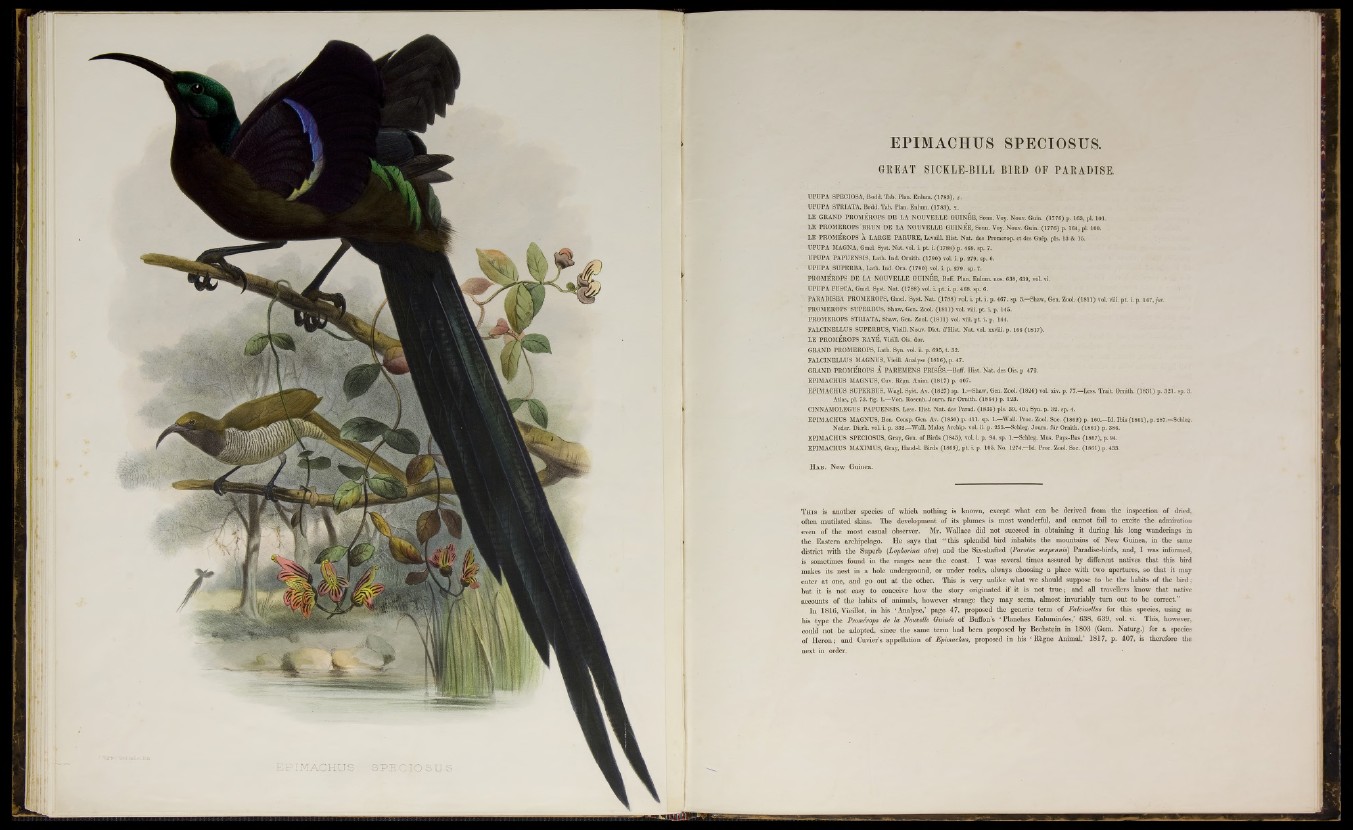
MACHLTS E B B
EPIMACHUS SPECIOSUS.
GREAT SICK LE-BIL L BIRD OF PARADISE.
UPUPA SPECIOSA, Boddi Tab. Plan. Enlum. (1783), j .
UPUPA STRIATA, Bo'dd. Tab. Plan. Enlum. (1 783), s .
LE GRAND PROMEROPS DE LA NOUVELLE GUINEE, Sonn. Voy. Nouv. Guin. (1 776) p. 163, pi. 101.
LE PROMEROPS BRUN DE LA NOUVELLE GUINEE, Sonn. Voy. Nouv. Guin. (1 776) p. 164, pl. 100.
LE PROMEROPS A LARGE PARURE, Levaill. Hist. Nat. des Promerop. et des Guêp. pis. 13 & 15.
UPUPA MAGNA, Gmel. Syst. Nat. vol. i. pt. i. (1788) p. 468. sp. 7.
UPUPA PAPUENSIS, Lath. Ind. Ornith. (1790) vol. i. p. 279. sp. 6.
UPUPA. SUPERBA, Lath. Ind. Om. (1 790) vol. i. p. 279. sp. 7.
PROMEROPS DE LA NOUVELLE GUINEE, Buff. Plan. Enlum. nos. 638, 639, vói. vi.
UPUPA FUSCA, Gmel. Syst. Nat. (1 788) voL i. pt. i. p. 468. sp. 6.
PARADISEA PROMEROPS, Gmel. Syst. Nat. (Í7 8 8 ) vol. i. pt. i. p. 467. sp. 3.—Shaw, Gen. Zool. (1811) vol. viii. pt. i. p. 147,ju v .
PROMEROPS SUPERBUS, Shaw, Gen. Zool. (1811) vol. viii. pt. i. p. 146.
PROMEROPS STRIATA, Shaw, Gen. Zobil; (1 811) voL vii&pfc i. p , 144.
FALCINELLUS SUPERBUS, Vieill. Nouv. Diet. d’Hist. Nat. vol. xxviii. p. 166 (1817).
LE PROMEROPS RAYE, Vieill. f i s . dor.
GRAND PROMEROPS, Lath. Syh. vol. ii. p. 696, t. 32.
FALCINELLUS MAGNUS, Vieill. Analyse (1816), p. 47.
GRAND PROMEROPS À PAREMENS FRISES.—Buff. Hist. Nat. des Ois. p 472.
EPIMACHUS MAGNUS,.Cuv. Règn. Anim. (1 817) p. 407.
EPIMACHUS SUPERBUS, Wagl. Syst. Av. (Í8 2 7 ) sp. 1.—Shaw, Gen. Zool. (1826) vol. xiv. p. 77.—Less. Trait. Omith. (1831) p. 321. sp. 3.
Atlas, pi. 73. fig. 1.—Von. Rosenb. Journ. fiir Ornith. (1864) p. 123.
CINNAMOLEGUS PAPUENSIS, Less. Hist. Nat. des Parad. (1835) pis. 39, 40 ; Syn. p. 32. sp. 4.
EPIMACHUS MAGNUS, Bon. Consp. Gen. Av. (Í8 5 0 ) p. 411. sp.g f e -Wall. Proc. Zool. Soc. (1 862) p. 160.—Id. Ibis (1 861), p. 28 7.-Schleg.
Neder. Dierk. vol. i. p. 332.—Wall. Malay Archip. vol. ii. p. 256.—Schleg. Journ. fiir Ornith. (1 861) p. 386.
EPIMACHUS SPECIOSUS, Gray, Gen. o f Birds (1 845), vol. i. p. 94. sp. 1.—Schleg. Mus. Pays-Bas (1867), p. 94.
EPIMACHUS MAXIMUS, Gray, Hand-1. Birds (1869), pt. i. p. 105. No. 1274.—Id. Proc. Zool. Soc. (1 861) p. 433.
H a b . New Guinea.
T h i s is another species of which nothing is known, except what can be derived from the inspection of dried,
often mutilated skins. The development of its plumes is most wonderful, and cannot fail to excite the admiration
even of the most casual observer. Mr. Wallace did not succeed in obtaining it during. his long wanderings in
the Eastern archipelago. He says that “ this splendid bird inhabits the mountains of New Guinea, in the same
district with the Superb (Lophorina atra) and the Six-shafted [Parotia sexpennis) Paradise-birds, and, I was informed,
is sometimes found in the ranges near the coast. I was several times assured by different natives that this bird
makes its nest in a hole underground, or under rocks, always choosing a place with two apertures, so that it may
enter at one, and go out at the other. This is very unlike what we should suppose to be the habits of the bird;
but it is not easy to conceive how the story originated if it is not tru e ; and all travellers know that native
accounts of the habits of animals, however strange they may seem, almost invariably turn out to be correct.”
In 1816, Vieillot, in his ‘Analyse,’ page 47, proposed the generic term of Falcinellus for this species, using as
his type the Promérops de la Nouvelle Guinée of Buffon’s ‘ Planches Enluminées,’ 638, 639, vol. vi. This, however,
could not be adopted, since the same term had been proposed by Bechstein in 1803 (Gem. Naturg.) for a species
of Heron; and Cuvier’s appellation of JEpimachus, proposed in his ‘Eigne Animal,’ 1817, p. 407, is therefore the
next in order. •